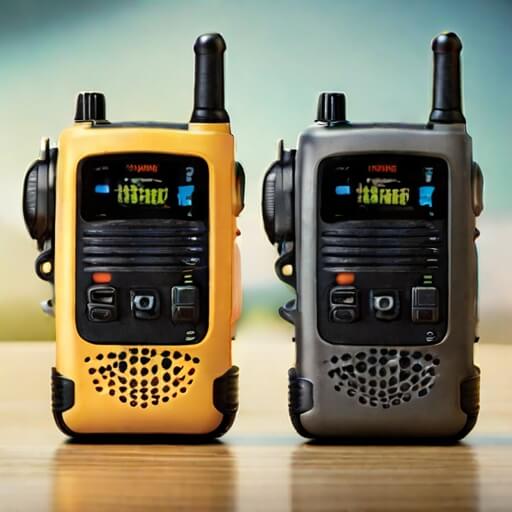Top 5 ham radios for off-grid communication
Table of Contents
- Baofeng UV-5R Dual Band Two-Way Radio
- Yaesu FT-65R Handheld Amateur Radio Transceiver
- TYT MD-380 Digital Two-Way Radio
- BaoFeng BF-F8HP (UV-82) Dual Band Two-Way Radio
- BTECH GMRS-V1 GMRS Two-Way Radio
- Conclusion
When venturing off the grid, whether for a hiking trip, camping, or in case of emergencies, reliable communication is vital. Ham radios, also known as amateur radios, are a popular choice for off-grid communication due to their ability to operate without relying on the internet or cell phone networks. In this article, we will explore the top 5 ham radios that are perfect for maintaining communication in remote areas.
Baofeng UV-5R Dual Band Two-Way Radio
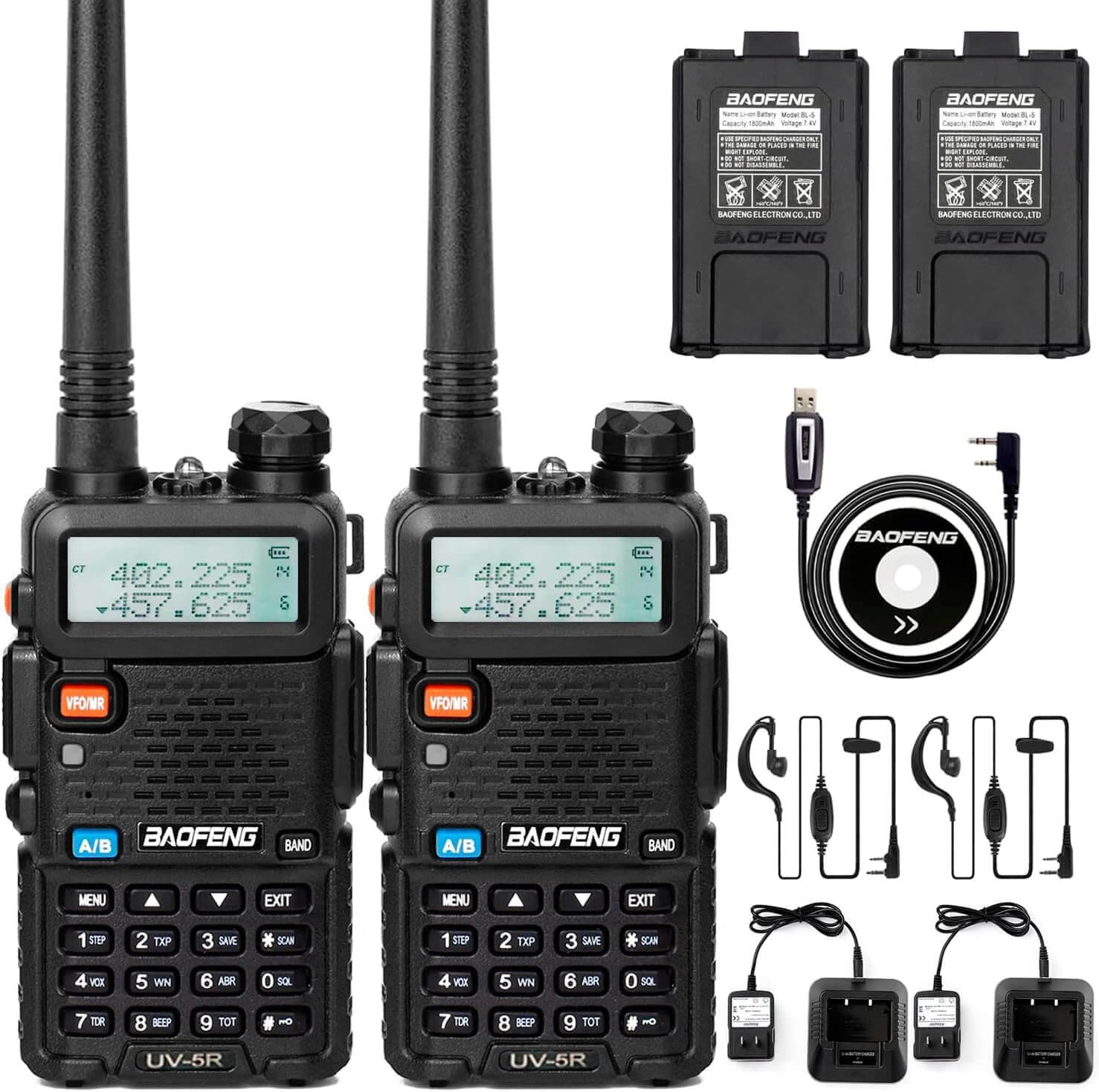
The Baofeng UV-5R is a dual-band handheld transceiver, making it a popular choice for beginner ham radio enthusiasts and hobbyists. It boasts affordability, user-friendly features, and VHF/UHF band compatibility, allowing communication on both 2 meter and 70 centimeter frequencies commonly used by amateur radio operators. However, it’s crucial to understand its limitations before purchasing.
Strengths:
- Budget-Friendly: The Baofeng UV-5R is one of the most affordable ham radios on the market, making it an attractive entry point for those new to the hobby.
- Easy to Use: The Baofeng UV-5R features a relatively simple menu system and basic controls, allowing beginners to learn the ropes of ham radio operation without feeling overwhelmed.
- Dual Band Support: The ability to transmit and receive on both the 2 meter (144-148 MHz) and 70 centimeter (420-450 MHz) bands allows users to access a wider range of communication channels.
- FM Radio Reception: The Baofeng UV-5R can also function as a basic FM radio receiver, providing entertainment options on the go.
Weaknesses:
- Limited Range: The Baofeng UV-5R’s stock antenna and low wattage output (up to 4 watts) limit its effective communication range, especially in areas with obstructions or challenging terrain. Upgrading the antenna can improve range to some extent.
- Durability Concerns: While generally considered functional, some user reviews mention potential quality control issues and concerns about the Baofeng UV-5R’s long-term durability compared to higher-end radios.
- Programming Complexity: Programming additional frequencies beyond pre-loaded channels can be a complex process for beginners, requiring research or familiarity with programming software.
- FCC Licensing Requirement: Operating a ham radio on most frequencies in the US requires a license from the FCC. Be sure to understand and comply with FCC regulations before transmitting.
Considering the Baofeng UV-5R:
The Baofeng UV-5R is a well-suited option for those seeking an affordable introduction to the world of ham radio. Its user-friendly features, dual-band support, and FM radio functionality make it an attractive starter kit. However, its limited range, potential durability concerns, and programming complexity are important factors to consider.
Here are some additional points to ponder before purchasing:
- Upgrade Potential: The Baofeng UV-5R can be accessorized with higher gain antennas for potentially improved range.
- Learning Resources: Numerous online resources and communities cater to Baofeng UV-5R users, offering guidance on programming, operation, and troubleshooting.
- FCC License Requirements: In the US, a Technician Class license is the minimum requirement to transmit on most ham radio frequencies. The FCC offers licensing information and resources https://www.fcc.gov/wireless/bureau-divisions/mobility-division/amateur-radio-service.
Overall, the Baofeng UV-5R can be a good value for beginners interested in exploring ham radio. However, for users seeking greater range, enhanced durability, or more advanced features, other ham radio options might be more suitable.
Yaesu FT-65R Handheld Amateur Radio Transceiver

The Yaesu FT-65R is a dual-band handheld transceiver favored by many ham radio operators for its reliability, user-friendly features, and overall performance. It offers communication capabilities on both the 2 meter (144-148 MHz) and 70 centimeter (420-450 MHz) bands, making it suitable for a variety of applications.
Strengths:
- Reliable Performance: Yaesu is a well-respected brand known for its quality ham radio equipment, and the FT-65R upholds that reputation. Users consistently report dependable operation and clear audio quality.
- User-Friendly Interface: The FT-65R offers a well-designed menu system with a backlit display, making it easier to navigate features and settings compared to some beginner radios.
- Durable Construction: The FT-65R boasts a sturdy and weatherproof build, ideal for outdoor use in various conditions.
- Functional Features: The radio includes handy features like Cross-Band Repeat, VOX (voice-activated transmission), and a built-in FM radio receiver, adding versatility to its communication capabilities.
- Improved Range (Compared to Baofeng UV-5R): With a slightly higher wattage output (up to 5 watts) than the Baofeng UV-5R, the FT-65R can offer potentially better communication range, especially with a good quality antenna.
Weaknesses:
- Higher Price Point: The Yaesu FT-65R is more expensive than some entry-level options like the Baofeng UV-5R.
- Larger Size and Weight: The FT-65R is slightly bigger and heavier than some competing radios, which might be a consideration for users who prioritize portability.
- Limited programmability compared to higher-end Yaesu models: While functional, the programmability of the FT-65R might be less extensive compared to some advanced Yaesu radios.
- FCC Licensing Requirement: As with most ham radios, operating the FT-65R on most frequencies requires a license from the FCC.
Considering the Yaesu FT-65R:
The Yaesu FT-65R strikes a good balance between affordability, user-friendliness, and reliable performance. Its sturdy build, clear audio, and functional features make it a popular choice for both beginner and experienced ham radio operators. However, the higher price tag, larger size, and limitations in programmability compared to some Yaesu models should be considered.
Here are some additional points to ponder before purchasing:
- Accessories: A higher gain antenna can further improve the FT-65R’s communication range.
- Learning Resources: Yaesu offers user manuals and online support resources to help users get the most out of the FT-65R.
- FCC License Requirements: In the US, a Technician Class license is the minimum requirement to transmit on most ham radio frequencies. The FCC offers licensing information and resources https://www.fcc.gov/wireless/bureau-divisions/mobility-division/amateur-radio-service.
Overall, the Yaesu FT-65R is a well-rounded ham radio transceiver that offers excellent value for its features and performance. It’s a reliable choice for those seeking a step up from entry-level options and a radio suitable for various communication needs.
TYT MD-380 Digital Two-Way Radio
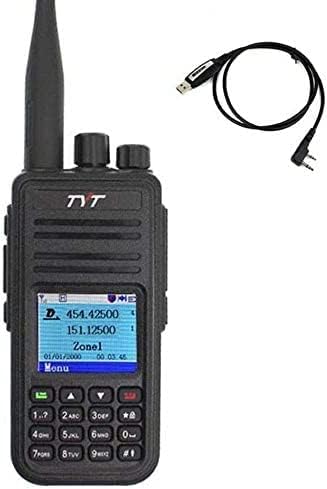
The TYT MD-380 is a UHF band (400-480 MHz) digital two-way radio offering an introduction to digital voice communication (DMR) for ham radio enthusiasts. It boasts affordability and the ability to operate in both digital and analog modes, making it an interesting choice for those curious about exploring DMR technology. However, there are key considerations before diving in.
Strengths:
- Digital and Analog Modes: The MD-380 offers the flexibility to switch between digital (DMR) and analog communication modes. This allows users to connect with both digital and analog contacts, potentially expanding communication reach.
- Clearer Audio in Digital Mode: DMR offers inherently clearer audio quality compared to analog communication, especially in noisy environments.
- Budget-Friendly: The TYT MD-380 is a more affordable option compared to some higher-end DMR radios.
- Compact and Portable: The MD-380’s lightweight and compact design makes it easy to carry around.
Weaknesses:
- Steeper Learning Curve: Understanding and using DMR features can be more complex compared to basic analog radios. Programming can also be a hurdle for beginners.
- Limited Functionality in Analog Mode: The MD-380’s analog mode may have some feature limitations compared to its digital mode.
- FCC Licensing Requirement for Digital Use: In the US, a Technician Class license is the minimum requirement to transmit on most frequencies, but a DMR license is needed for digital transmissions on specific channels. Understand FCC regulations before operating in DMR mode https://www.fcc.gov/wireless/bureau-divisions/mobility-division/amateur-radio-service.
- Mixed Reviews on Durability: While some users report good experiences, others express concerns about the MD-380’s long-term durability compared to some competitor radios.
Considering the TYT MD-380:
The TYT MD-380 presents a tempting gateway to the world of DMR for budget-conscious ham radio users. The ability to switch between digital and analog modes offers flexibility, and the compact design is a plus for portability. However, the steeper learning curve for DMR operation, limitations in analog mode, and the need for a separate DMR license for digital use are important factors to consider.
Here are some additional points to ponder before purchasing:
- Learning Resources: Online resources and communities can help users navigate DMR programming and operation with the TYT MD-380.
- Programming Software: Third-party software might be needed for easier programming of the MD-380 compared to using the stock software.
- Upgrade Potential: Higher gain antennas can potentially improve the MD-380’s communication range.
Overall, the TYT MD-380 can be a suitable choice for budget-minded ham radio users interested in exploring DMR technology. However, for those new to ham radio or those prioritizing ease of use and analog functionality, other options might be more appropriate.
BaoFeng BF-F8HP (UV-82) Dual Band Two-Way Radio
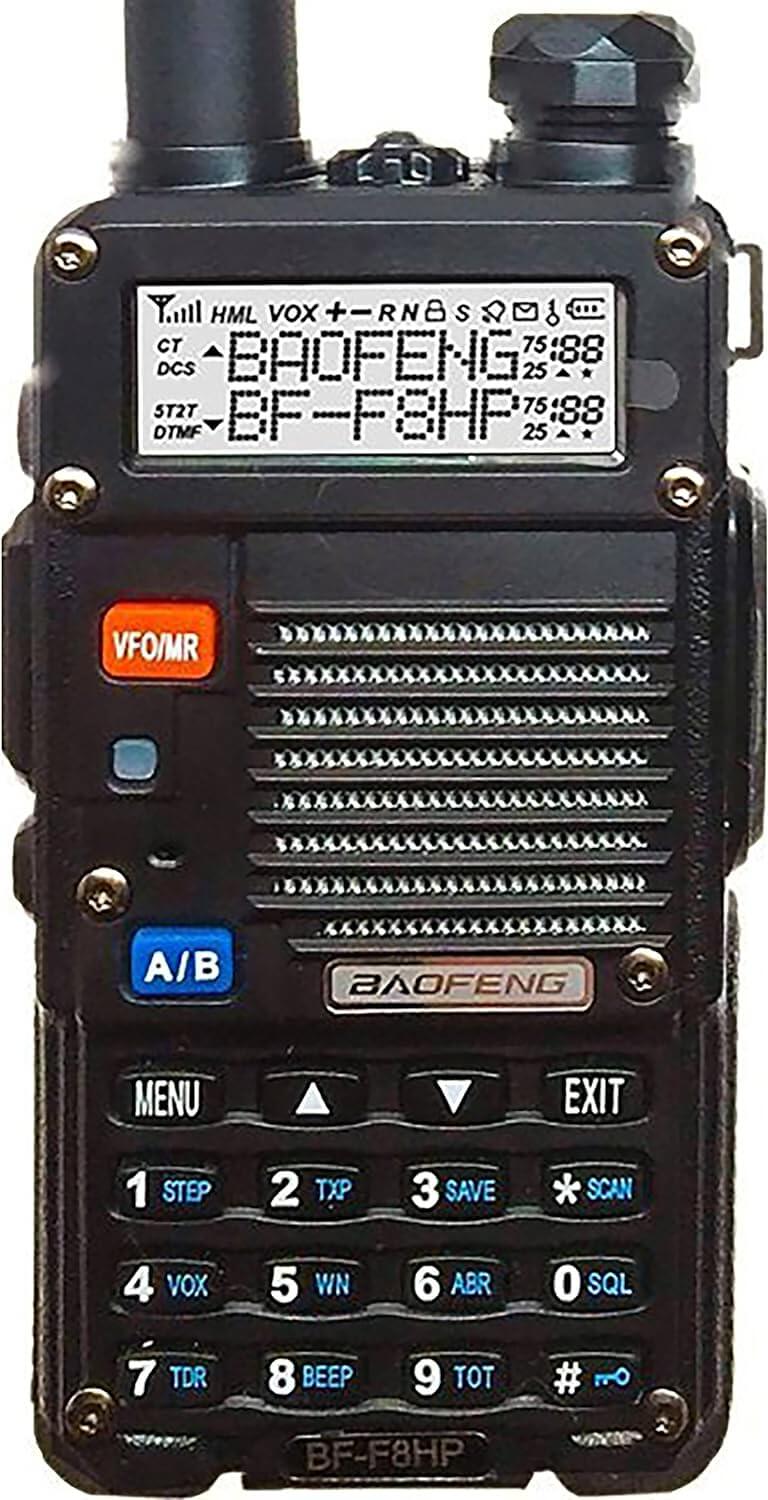
The BaoFeng BF-F8HP (UV-82) is a dual-band handheld transceiver positioned as an upgrade to the popular Baofeng UV-5R. It boasts increased wattage output, a larger battery, and a few additional features. However, it also inherits some of the controversies surrounding the BaoFeng brand, making it a choice that warrants careful consideration.
Strengths:
- Increased Wattage: Compared to the UV-5R’s 4 watts, the BF-F8HP offers selectable power levels of 1 watt, 4/5 watts, and a high setting of 7/8 watts, potentially improving communication range.
- Larger Battery: The BF-F8HP boasts a larger battery capacity, translating to potentially longer operating times on a single charge.
- Tri-Color Display: The BF-F8HP features a customizable tri-color display, offering some personalization options compared to the UV-5R.
- More Rugged Construction: Some users report the BF-F8HP feeling sturdier than the UV-5R.
Weaknesses:
- Potential Programming Challenges: While featuring similar programming to the UV-5R, some users find the menu system less intuitive, especially for beginners.
- Questionable Durability: Concerns linger about the BF-F8HP’s long-term durability compared to some competitor radios, with user experiences varying.
- Overheating Potential at High Power: There are reports of the BF-F8HP overheating at higher power levels, potentially impacting performance and reliability.
- FCC Licensing Requirement: As with most ham radios, operating the BF-F8HP on most frequencies requires an FCC license.
Controversies and Considerations:
BaoFeng radios, including the BF-F8HP, have been linked to exceeding FCC power output limits in certain situations. It’s crucial to ensure proper programming and operation within legal limitations to avoid exceeding allowed wattage. Additionally, some BaoFeng models have raised concerns about being easily modified for use on restricted frequencies. Upholding FCC regulations and ethical operation are paramount when using any ham radio.
Considering the BaoFeng BF-F8HP (UV-82):
The BaoFeng BF-F8HP offers more power and features compared to the Baofeng UV-5R, potentially appealing to users seeking improved range and battery life. However, the potential programming difficulties, durability concerns, overheating risks, and the cloud of controversy surrounding BaoFeng radios are significant factors to weigh.
Here are some additional points to ponder before purchasing:
- Learning Resources: Online resources and communities can be helpful for navigating programming and operation of the BF-F8HP.
- Upgrading the Antenna: A higher gain antenna can further improve the BF-F8HP’s communication range.
- Understanding FCC Regulations: Familiarize yourself with FCC regulations regarding ham radio operation, power output limits, and licensing requirements https://www.fcc.gov/wireless/bureau-divisions/mobility-division/amateur-radio-service.
Overall, the BaoFeng BF-F8HP presents a potential upgrade path for Baofeng enthusiasts seeking more power and features. However, for those new to ham radio or prioritizing ease of use, reliable performance, and a brand with a stronger reputation for responsible operation, other options might be more suitable.
BTECH GMRS-V2 GMRS Two-Way Radio
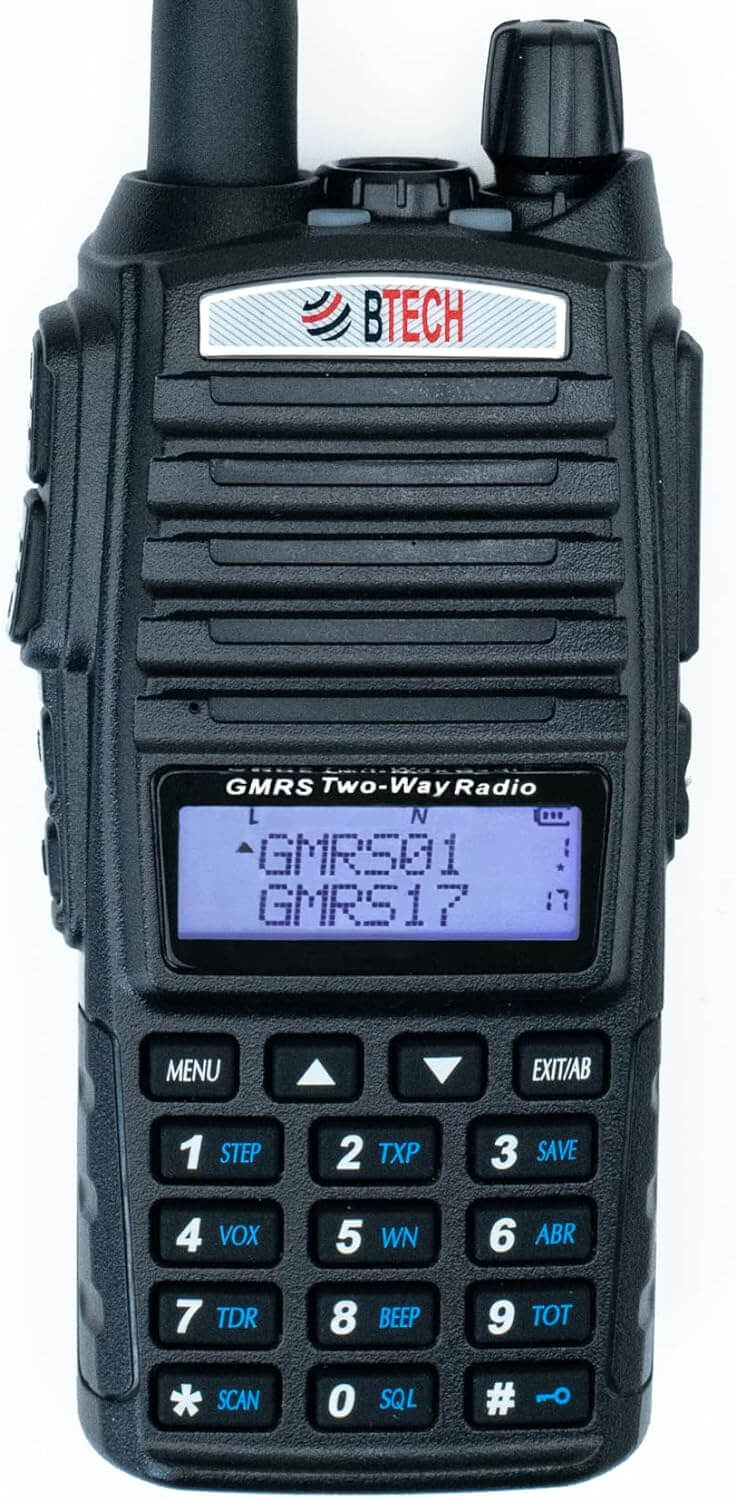
The BTECH GMRS-V2 is a two-way radio designed for use with the General Mobile Radio Service (GMRS) in the United States. It boasts a variety of features and functionalities, making it an attractive option for short-range communication needs within the GMRS band. However, it’s crucial to understand its limitations and GMRS licensing requirements before purchasing.
Strengths:
- GMRS License-Free Operation (Low Power): The BTECH GMRS-V2 can be operated on low power (around 500 milliwatts) without a GMRS license. This makes it suitable for basic communication needs within a limited range.
- Higher Power with GMRS License: A GMRS license allows operation at higher power levels (up to 5 watts), potentially improving communication range.
- Dual Receive and Dual Standby: The BTECH GMRS-V2 can monitor two channels simultaneously while being ready to transmit on another, enhancing versatility.
- NOAA Weather Radio Reception: The radio can receive NOAA weather broadcasts, providing valuable information during outdoor activities.
- Improved Receiver Performance: BTECH claims superior receiver design compared to some competitors, potentially resulting in clearer audio reception.
Weaknesses:
- Limited Range: Even at higher power levels, the BTECH GMRS-V2’s range is generally limited to a few miles due to its use of lower frequencies in the GMRS band.
- Not a Ham Radio: The BTECH GMRS-V2 operates on the GMRS band and is not a ham radio. It cannot be used on most amateur radio frequencies, which require a separate ham radio license.
- Programming Complexity for Advanced Features: While basic operation is straightforward, programming advanced features like channel scanning can be more complex for beginners.
- Limited User Reviews: As a relatively new product, the BTECH GMRS-V2 has fewer user reviews compared to some established models, making it difficult to gauge long-term durability and real-world performance.
GMRS Licensing Considerations:
Operating the BTECH GMRS-V2 at higher power levels (above 500 milliwatts) requires a GMRS license from the FCC. Obtaining a GMRS license is simpler than a ham radio license but still involves fees and registration processes.
Considering the BTECH GMRS-V2:
The BTECH GMRS-V2 caters to users seeking a feature-rich option for short-range communication within the GMRS band. Its dual receive/standby functionality, NOAA weather reception, and supposedly improved receiver performance are notable features. However, the limited range, requirement for a GMRS license for higher power use, and the fact that it’s not a ham radio are important considerations.
Here are some additional points to ponder before purchasing:
- Alternatives: For needs beyond short-range communication, consider ham radios offering greater range but requiring a ham radio license. There are also other GMRS radios in the market with similar functionalities.
- Understanding GMRS Regulations: Familiarize yourself with FCC regulations regarding GMRS licensing and operation before using the BTECH GMRS-V2 at higher power levels https://www.fcc.gov/general/general-mobile-radio-service-gmrs.
- Upgrading the Antenna: A higher gain antenna can potentially improve the BTECH GMRS-V2’s communication range to some extent.
Overall, the BTECH GMRS-V2 is a promising option for short-range GMRS communication, especially for those who value features like dual receive/standby and NOAA weather reception. However, with limited user reviews at this
Conclusion
In summary:
1. Baofeng UV-5R: The budget-friendly champion for beginners. Easy to use, dual-band, but limited range and durability concerns exist. Requires a license for most transmissions.
2. Yaesu FT-65R: Reliable and user-friendly with improved range (compared to Baofeng). More expensive but offers better build quality and features like weather channels. Requires a license for most transmissions.
3. TYT MD-380: Explore digital communication (DMR) at an affordable price. Offers both digital and analog modes for flexibility, but steeper learning curve and potential limitations exist. Requires a license for digital use on specific channels.
4. BaoFeng BF-F8HP (UV-82): More power and features compared to the Baofeng UV-5R, but potential programming difficulties and durability concerns linger. Ensure proper use within FCC regulations. Requires a license for most transmissions.
5. BTECH GMRS-V2: Feature-rich for short-range (GMRS band) communication. License-free at low power, but requires a GMRS license for higher power. Not a ham radio and has limited range compared to some options.
Remember, a license is required for most ham radio operations in the US. Consider your needs (range, features, budget) and research FCC regulations before choosing your ideal two-way radio.
